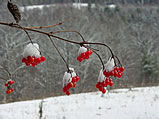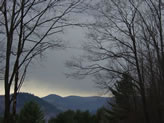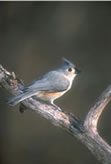
Nature Journal
| |
|
| Sunday, December 8, 2002 | |
| Saw
some red fox tracks today. Got me thinking
and doing some reading about the fox. This mammal has an incredible sense of hearing. It locates mice in the grass - or under the snow - by the sound of their little rustlings. The red fox also has extremely good night vision and a keen sense of smell - which are both obviously a big advantage when tracking prey. Its sense of smell also comes in handy when locating caches of food that it has previously hidden. |
|
| Saturday, December 7, 2002 | |
 Nature
paints some pretty pictures. Nature
paints some pretty pictures.And here's one of them. (Hmmm, doesn't look like much unless you enlarge it , tho'.) These are highbush cranberries hanging on a bush I walk by regularly. A few inches of fluffy |
|
| Friday, December 6, 2002 | |
| I
heard the hooting of the barred owl
yesterday evening. Instead its more usual "hoo-hoo-hoohoo"
sound, it was just calling a soft "hoo-aw" - with a downward
inflection. It made this sound over and over at regular intervals
until it was out of earshot. I sometimes wake up at night to the sound of the barred owl - and I don't mind it one bit! When there's more than one of them, they often hoot back and forth - making quite a racket. I enjoy every moment of it. Now, I have to admit, if it went on for hours I don't think I'd like it quite as much. :) |
|
| Thursday, December 5, 2002 | |
 When
I saw this beautiful glow in the sky behind the mountains, I ran into
the house to get my camera. When
I saw this beautiful glow in the sky behind the mountains, I ran into
the house to get my camera.I continue to be amazed at how these mountains can look so different at various times of the day and of the year. |
|
Just an hour or two can go by - and I'll look out the window and see a whole new scene. It's wonderful! |
|
| Wednesday, December 4, 2002 | |
| I've
been seeing some species of moth flying around outside for the past
month or so. It doesn't seem to be bothered by the cold weather. Haven't
been able to identify it yet or get a photo. It's sort of a white/gray
color and is very active - I've never seen it light on anything (tho'
I'm sure it must!). Here's some interesting info from the Smithsonian Institute about where insects go in the winter. |
|
| Tuesday, December 3, 2002 | |
|
|
|
| Photo © Don DesJardin | |
|
I also saw an American tree sparrow
among the juncos feeding below my bird feeder, so I guess the sparrows are going to stick around this area after all. After not seeing them for the past month, I thought they'd gone further south - or elsewhere. |
|
| Monday, December 2, 2002 | |
|
There's
a woodchuck that's been living in
the retaining wall near my house. (Was successful in keeping it
out for a couple of years, but it managed to make a den there this
summer.) I just realized that the reason I haven't seen it for a
long time is because it's hibernating. |
|
| Top of page | |
|
|
| Birds | Butterflies | Mammals |
| Garden Shop |
New England:
Connecticut, Maine, Massachusetts, New Hampshire, Rhode Island, Vermont
 In
past years, the
In
past years, the